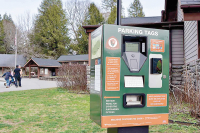Spreading seeds — a special feat
While conducting plant identification workshops, I always try to remember to discuss two aspects that are essential if one is really going to enjoy plants. I think of these as plant “strategies.” They have to do with pollination and seed dispersal.
First, everything about a flower — color, fragrance, shape, whatever — is connected with the need for attracting pollinators (usually insects) in order to accomplish fertilization. Think of a violet. It has color and fragrance that help an insect locate a source of energy. But violets also assist the insect via a lower petal that serves as a landing platform. And furthermore, there are delicate lines in the petals that guide the insect past the sexual parts of the plant to the nectar. Called “nectar guides” by botanists, these are the equivalent of lights on an airplane runway. One can usually examine a given flower and figure out its pollination strategies.
Second, everything about a fruiting structure — dandelion seeds that become airborne, fruits and seeds that float, fruits that attract animals to devour them, whatever — is connected with the need to disperse seeds. Some plants like, say, touch-me-not, don’t require wide seeds dispersal. When the touch-me-not’s pod is fully mature, it “explodes” and the seeds are propelled for a few feet as the rubbery strands they are connected to suddenly uncoil. Magnolia trees, however, require much wider seed dispersal. Their seeds would never prosper under the shade of the parent tree. If you examine a magnolia cone in the fall, you’ll observe that the extruded seeds aren’t allowed to fall to the ground. Instead, they dangle on short rubbery strands called “funicular strands.” Their bright scarlet color helps birds locate the seeds and thereby disperse them widely.
I could go on about pollination and seed dispersal strategies ad infinitum. But you get the picture. These are pretty simple concepts. Sometimes, however, it’s the most basic notions that are the most illuminating.
Fungi, of course, don’t utilize flowers or seeds to reproduce. They are non-vascular and reproduce via spores. The above ground portion that we usually call a mushroom is actually the fruiting structure. (These are produced from underground strands called mycelium.) Fungi spores are most often dispersed from gill slits or tubes underneath the cap. One of the methods utilized in mushroom identification is to make a “spoor print” by breaking off the cap and leaving it overnight (fat side down) on a white piece of paper. These prints can be quite beautiful in regard to color and conformation. And they are often diagnostic to species level.
Related Items
One type of fungi commonly called puffballs don’t have gills or tubes; indeed, they don’t even have caps. Most everyone is familiar with puffballs. Appearing in fields or other open areas, various species can be smaller than golf balls or almost as large as volleyballs. Many are edible before they fully ripen.
Most puffballs utilize a very primitive way of accomplishing spore dispersal. Once the puffball ripens, the outer membrane containing the spores becomes dry and cracks open. Wind, falling debris, raindrops, and other agents hitting the puffball cause the spores to pop out. It’s that simple. But it’s a crude method — all of the spores in a given puffball aren’t usually dispersed and thereby go to waste.
There is a category of puffballs known as earthstars. These have a hard outer membrane that peels back as the earthstar ripens and reveals a puffball-like inner core. (These star-like fruiting structures are also quite beautiful in regard to color and conformation.) Most earthstars then disperse their spores like other puffballs. But one species called the barometer earthstar (Astreus hygometricus) has devised an ingenious mechanism whereby full spore dispersal is obtained.
As the common name indicates, the outer covering of the barometer earthstar is sensitive to meteorological conditions. During wet weather the outer covering remains open and some spores are no doubt dispersed in the normal puffball manner. But during dry weather the outer covering contracts and closes in on top of the inner core thereby squeezing out any spores that remain.
Field guides usually indicate that most earthstars appear in late summer or fall. For whatever reason, I spot them more frequently in early or late winter during rainy periods when the fruiting structures are fully open. Perhaps I don’t observe them at other times because of leaf litter.
George Ellison wrote the biographical introductions for the reissues of two Appalachian classics: Horace Kephart’s Our Southern Highlanders and James Mooney’s History, Myths, and Sacred Formulas of the Cherokees. In June 2005, a selection of his Back Then columns was published by The History Press in Charleston as Mountain Passages: Natural and Cultural History of Western North Carolina and the Great Smoky Mountains. Readers can contact him at P.O. Box 1262, Bryson City, N.C., 28713, or at This email address is being protected from spambots. You need JavaScript enabled to view it..









